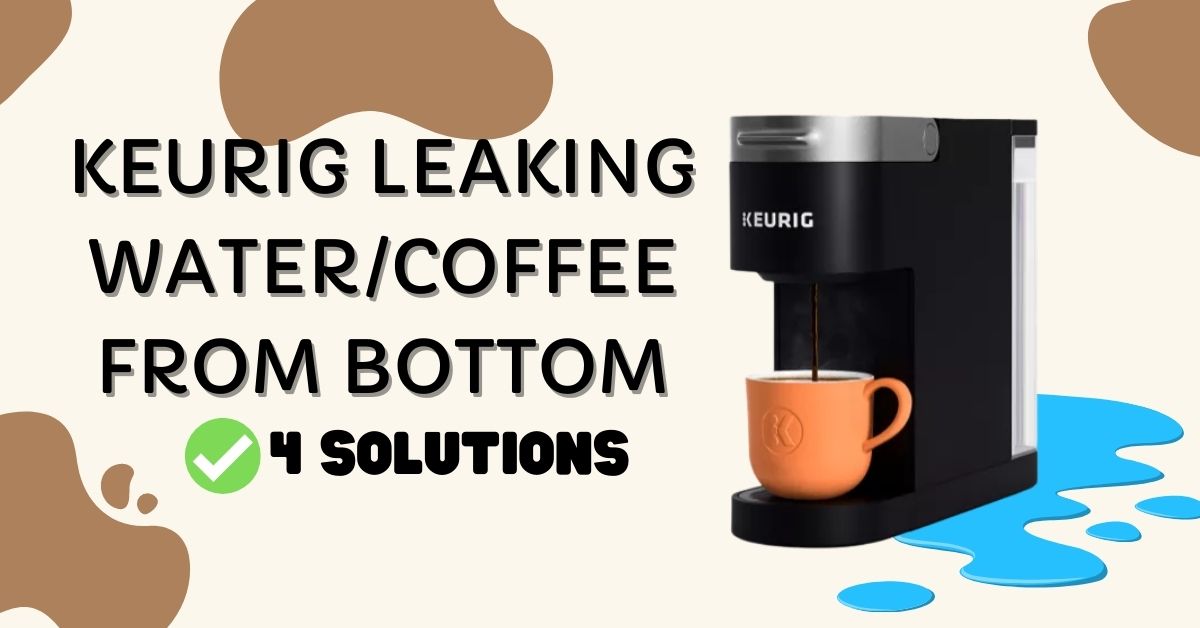Coffee lovers appreciate Keurig coffee makers’ convenience and consistency in brewing that perfect cup. Yet, encountering a Keurig leaking from the bottom can dampen this experience, turning a moment of pleasure into a time of frustration. Fortunately, this common issue can often be resolved without professional help.
In this piece, we delve deep into the various reasons behind this problem and offer you detailed solutions to get your Keurig functioning perfectly again.
How to Fix Keurig Leaking From Bottom Issue
There are several possible reasons why your Keurig is leaking from the bottom. The good news is that most of these causes can be fixed without bringing your machine into a repair shop. Here are some common problems and solutions:
1. Faulty O-Ring
A Keurig leaking from the bottom often points to issues with the O-ring, a vital component that ensures a tight seal between the water reservoir and the machine. It’s located where the hose connects to the water tank. If this part becomes damaged or worn down, it may be necessary to replace it to stop any potential leaks from occurring.
Inspection for Presence – The first step is to ensure the O-ring is still in place. Vibrations during brewing can sometimes displace it. If it is missing, you will need to replace it. Ensure to purchase one that is compatible with your Keurig model.
Checking the Condition – If the O-ring is present, inspect it closely for any signs of wear, tear, or damage. Over time, it can become brittle and lose its elasticity, compromising its sealing ability.
Ensure it is Properly Aligned – Sometimes, the issue is as simple as the O-ring not being properly aligned. In such cases, gently reposition it to its original place to ensure a snug fit.
Replacement – If the O-ring is damaged, a replacement becomes inevitable. Installing a new O-ring around the water reservoir feed can be a preventive measure against leaks. Suitable O-ring sizes are generally 7×2 or 8×2, but always confirm the size compatible with your Keurig model.
If the O-Ring is in good condition and positioned correctly, the water tank may be causing the problem.
2. Inspect The Water Reservoir
A cracked water reservoir is a common culprit behind a Keurig coffee maker leaking from the bottom. Begin with a detailed visual inspection. Look for cracks or damages on the sides and the bottom of the reservoir.
Cloth Test: To identify less obvious leaks, conduct the cloth test. Fill the reservoir with water and place it on a dry cloth for about 20-30 minutes. If you find the cloth wet, it indicates a leak, signaling that further inspection is needed.
If the leak is occurring at the junction where the reservoir connects to the machine, applying silicone grease can sometimes solve the problem. This method is particularly effective in sealing minor leaks.
If you identify cracks, you have two options: repair or replace. While minor cracks can be sealed using food-safe silicone sealant or hot glue, a replacement is often the more reliable and long-term solution. If a repair seems unfeasible, opt for a replacement. Ensure to purchase a reservoir compatible with your specific Keurig model to avoid future leaks.
3. Keurig Needs Descaling
Descaling is a maintenance routine and a solution to prevent your Keurig from leaking water after brewing. The process removes mineral build-ups that can clog pathways and cause leaks.
Keurig recommends descaling every 3 to 6 months or after every 300 cups of coffee to prevent issues like leaking and to maintain the coffee’s taste.
If you let the machine sit for a long time, you must descale it immediately. With just a few simple steps, you can descale it yourself and save time and money on costly service calls. If you have a descaling solution, follow the packaging directions. You can buy one online if you don’t have one.
Descaling Process: Remove detachable components such as the drip tray, water reservoir, and capsule holder. Clean them with warm, soapy water. Run a descaling cycle using a descaling solution or a vinegar-water mix, followed by 1 to 2 rinsing cycles with hot water to remove any residual vinegar taste.
4. Advance Keurig Leak Issues
If you have eliminated the above possibilities for why your Keurig leaks from the bottom, the issue is likely due to a broken internal part. Commonly, this can be the upper gasket, tube connectors, filters, water line circuit, heating element, or internal pipes.
Diagnosing and replacing these parts requires a very advanced level of knowledge and skill. If you feel uncomfortable opening up your coffee maker, it is best to contact Keurig customer support to learn more about how they can help you with a repair. Opening up your machine may also void your warranty.
Although there are video tutorials available online, we recommend you do NOT attempt to fix the problem yourself unless you are confident in your own abilities.
If your Keurig is leaking from the top, I have also written a guide on that.
Keurig Leaking From Bottom Video Tutorial
Conclusion
While it is disheartening to see your favorite coffee maker malfunction, understanding the potential causes and solutions can be empowering. By following this guide, you equip yourself with the knowledge to identify and fix issues of your Keurig leaking from the bottom, ensuring many more mornings of the perfect brew.


